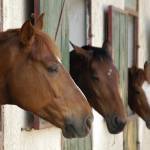Winter Horse Barns Need Good Ventilation

Providing clean air is a key to keeping horses healthy in any season. Pastured horses are naturally exposed to fresh air, and stalled horses usually benefit from open windows and fans in the summer. However, as soon as the weather begins to get cold, the tendency is to put fans away, close barn doors and windows, and block the entry of chilly breezes.
Though a warm, airtight barn may initially seem to be a good idea, the opposite is actually healthier for horses. As long as strong winds are blocked by barn walls, dry horses will usually stay comfortable even in unheated barns, where there is a constant air exchange.
Horses produce a lot of body heat due to the fermentation of fiber in the hindgut. They also exhale moisture with every breath. Warm, moist air rises until it meets the cold barn roof. Especially in barns with metal roofs, moisture condenses as it hits the cold surface, and drops of water begin to fall back down into the stalls. If hay is stored in the barn loft, a surprising amount of moisture can collect in the top layer of bales during the course of a winter.
In the stall, the horse’s movements stir up dust from hay and bedding. Inhaled particles of mold and allergens are irritating to the horse’s respiratory tract, as are ammonia fumes from wet bedding.
The combination of moisture and dust adds up to an unhealthy situation that can easily be prevented by designing barns to promote the circulation of air, allowing inside air to escape and be continuously replaced by fresh air from outside the barn. Owners who are considering building or modifying a barn should be sure that the design takes this important concern into consideration.
Because getting rid of warm, moist air is so important, the design should include a way for that rising air to escape at or near the top of the barn. Vents at the ridgeline and at the ends of the barn will help, as will an open space at the top of stall walls just under the eaves. A cupola on the roof is an attractive barn feature that also aids ventilation.
With air leaving at the top of the barn, fresh air must also be allowed to enter the barn at lower levels. In wooden barns, this is usually an automatic function because there is adequate space between the wall boards for fresh air to filter in. If the barn is constructed of metal, concrete, or another solid material, the design should include vents or spaces where outside air can enter. However, providing air exchange does not mean that a gale of cold wind needs to be gusting through the barn. Several small vents are preferable to a few large openings such as windows that may allow a draft to blow directly on the horses.
Though good barn ventilation is important for the respiratory health of all equines, some horses may need additional help staying warm in bitterly cold, windy weather. Very old, very young, sick, or extremely thin horses may need to be blanketed or kept into deep-bedded stalls to keep them from becoming dangerously chilled. Horses that have been clipped will also need to be blanketed because their natural insulation has been removed.
Owners need to be sure that all horses have shelter (a run-in shed or windbreak may be sufficient), water that is not frozen, and a steady supply of good-quality hay throughout the winter. For horses that spend all or part of each day inside, barns don’t need to be warm, and certainly should not be airtight. Simply getting horses out of the wind is often adequate to keep them comfortable in cold weather.








